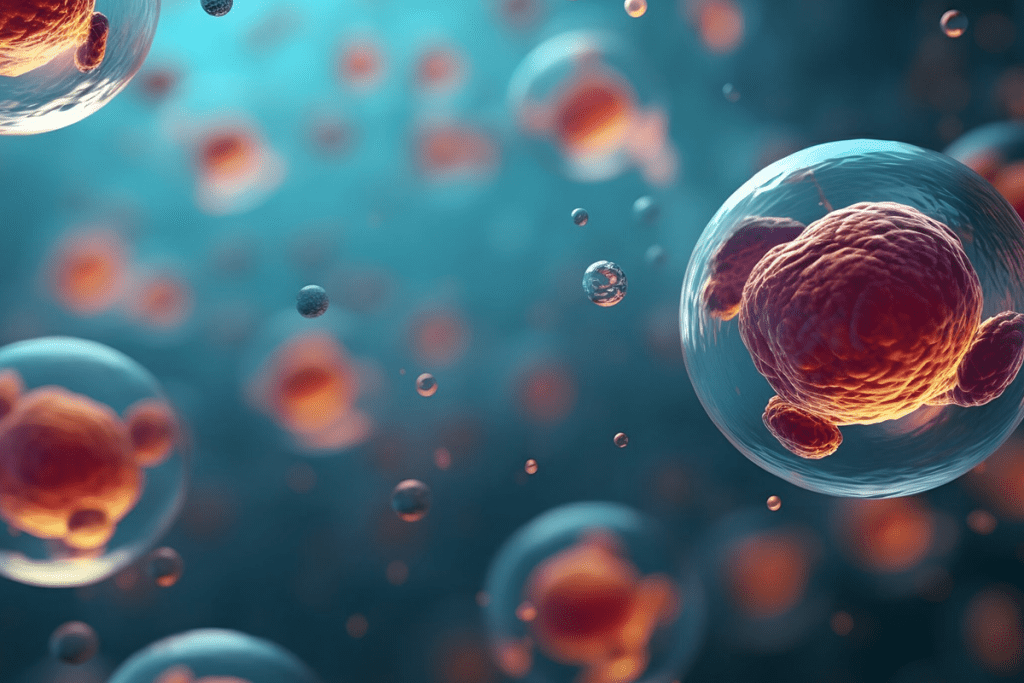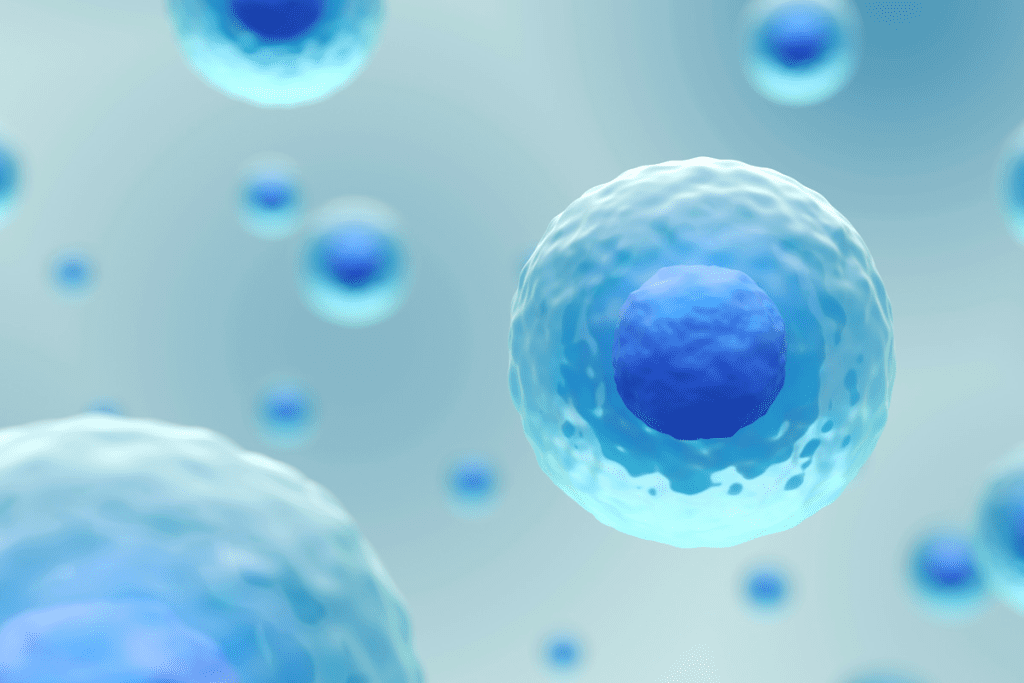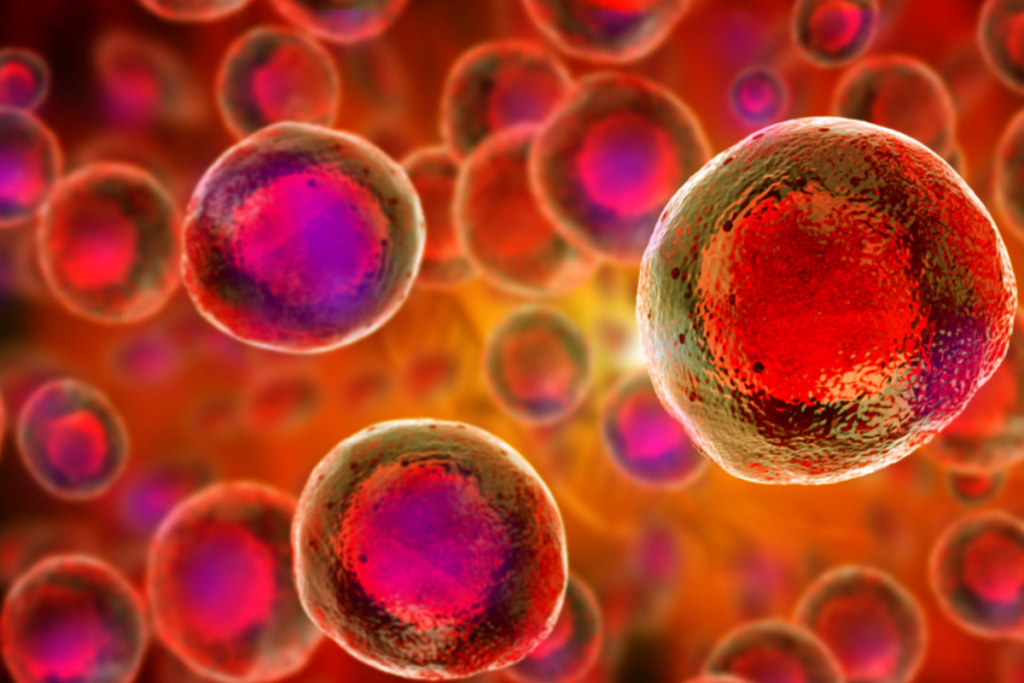Last Updated on October 22, 2025 by mcelik

Multipotent stem cells are essential for medical research, helping us understand human growth, disease, and healing. These cells, also called adult or somatic stem cells, can turn into different types of cells. This is within a specific group or tissue.
The power of multipotency is huge for fixing damaged tissues. It opens up new ways to treat many diseases and injuries. Scientists are learning how these cells work. This knowledge helps them create new treatments.
Stem cells can grow and turn into different types of cells. This ability makes them very important in studying how we grow, get sick, and how we might heal. They are key to understanding many things in biology.
Stem cells are unspecialized cells that can become many types of cells. They are sorted by their potency, which shows how many types of cells they can become. Knowing this helps us see how stem cells work in our bodies.
It’s very important to sort stem cells to know how they can help us. There are totipotent, pluripotent, and multipotent stem cells, each with its own powers. Knowing which one is best for a treatment is key.
Also, knowing the difference between multipotent and pluripotent stem cells is important. This knowledge is vital for both research and using stem cells to help people.
Multipotent stem cells can grow into many cell types within a certain group. This makes them very useful in medical studies and regenerative medicine. They can’t turn into any cell type like pluripotent stem cells can. Instead, they are limited to specific tissues or organs.
Multipotency means a stem cell can become different cell types, but only in certain tissues. For example, blood stem cells can make all blood cells, like red and white blood cells, and platelets. This is what sets multipotent stem cells apart from pluripotent ones.
Multipotent stem cells can only grow into specific cell types. Mesenchymal stem cells, for example, can become bone, cartilage, or fat cells. This is key for fixing damaged tissues and growing new ones. By studying how these stem cells grow, scientists can create new treatments for many diseases and injuries.
Special cellular markers help find multipotent stem cells. These markers are proteins or antigens on the cells’ surface. For instance, blood stem cells have CD34 and CD45 markers. Knowing these markers is vital for finding these stem cells for research and treatments.
Multipotent stem cells have many names, showing their varied roles and places in the body. Knowing these names helps us understand their unique traits and roles in medical studies.
“Adult stem cells” is another name for these cells. It points out they are found in adults, unlike embryonic stem cells. They are key in keeping tissues healthy and fixing them when needed.
They are also called “somatic stem cells.” This name shows they come from the body’s tissues. It points to their role in growing and fixing body tissues.
“Tissue-specific stem cells” are named for their ability to turn into specific cell types in certain tissues. This is key for keeping tissues balanced.
Some are called “regional stem cells.” This name shows they work in specific areas of the body. Their localized action is vital for fixing tissues.
| Name | Description | Key Characteristics |
| Adult Stem Cells | Found in adult tissues | Tissue maintenance and repair |
| Somatic Stem Cells | Originate from somatic tissues | Role in development and regeneration |
| Tissue-Specific Stem Cells | Confined to specific tissues | Tissue homeostasis |
| Regional Stem Cells | Localized presence | Targeted tissue repair |

It’s essential to know about the different levels of stem cell potency. This helps us see how these cells play a big role in growth and repair. Stem cells are sorted by their ability to differentiate into various cell types within our bodies.
Totipotent stem cells are the most powerful. They can turn into any cell type, including those outside the embryo. This means they can make a whole new organism. We see this power in the very early stages of a baby’s development.
Pluripotent stem cells can turn into almost any cell type, except for some outside the embryo. They are key for growing embryos and have a big role in fixing damaged tissues. Their wide range of possibilities makes them very useful in medicine.
Multipotent stem cells can differentiate into several cell types, but only within specific cell lineage groups. For example, blood-making stem cells can create all kinds of blood cells. This demonstrates their ability to produce various types of blood cells.
Oligopotent stem cells can only turn into a few related cell types. They are less versatile than multipotent stem cells. For instance, cells that make immune cells can only make a few types of immune cells.
The hierarchy of stem cell potency is shown in the table below:
| Potency Level | Differentiation Capacity | Examples |
| Totipotent | All cell types, including extraembryonic tissues | Zygote, early embryonic cells |
| Pluripotent | Almost any cell type within the body | Embryonic stem cells |
| Multipotent | Multiple cell types within a specific lineage | Hematopoietic stem cells, mesenchymal stem cells |
| Oligopotent | A few closely related cell types | Lymphoid progenitor cells |
Knowing about the different levels of stem cell potency is key for improving medicine. Each level has its own benefits and challenges for treating diseases.

Multipotent and pluripotent stem cells differ in their ability to become different cell types. They also vary in where they come from and the ethics of using them. This knowledge is key to understanding their roles in science and medicine.
Multipotent stem cells can turn into several cell types but only within certain limits. Pluripotent stem cells, on the other hand, can become almost any cell type in the body. This makes pluripotent stem cells more useful for fixing damaged tissues.
Multipotent stem cells are found in adult tissues and help fix and maintain tissues. Pluripotent stem cells come from embryos or are made artificially. This makes pluripotent stem cells more controversial.
Using stem cells raises ethical questions. Pluripotent stem cells, made from embryos, are a big concern. Multipotent stem cells, from adult tissues, are less debated.
Both stem cells have their uses. Multipotent stem cells are good for fixing specific tissues. Pluripotent stem cells can make many cell types, useful for treatments and studying diseases.
Multipotent stem cells are found in many parts of our body. They help keep tissues healthy and fix them when needed. These cells can turn into different types of cells, which is key for healing and keeping balance in our body.
Hematopoietic stem cells live in our bone marrow. They make all kinds of blood cells, like red and white blood cells, and platelets.
Mesenchymal Stem Cells
Mesenchymal stem cells are found in fat, bone marrow, and dental pulp. They can turn into different types of cells, like bone and fat cells. They also help our immune system, making them great for healing.
Neural stem cells live in certain parts of the brain. They can become different types of brain cells.
Epithelial Stem Cells
Epithelial stem cells are in the skin, gut, and lungs. They keep these areas healthy by turning into different types of cells. They are key for fixing tissues when they get damaged.
In summary, multipotent stem cells are everywhere in our body. They help fix and keep tissues healthy. Learning about them is important for finding new ways to heal and repair our bodies.
Many tissues are rich in multipotent stem cells, important for medical research. These cells can be found in bone marrow, adipose tissue, umbilical cord blood, and dental pulp.
Bone marrow is a key source of stem cells. It contains hematopoietic stem cells and mesenchymal stem cells. Hematopoietic stem cells make blood cells. Mesenchymal stem cells can differentiate into various cell types, such as bone and fat cells.
Adipose tissue, or fat, is also a source of stem cells called adipose-derived stem cells (ASCs). ASCs can become many cell types. This makes them useful for fixing damaged tissues.
Umbilical cord blood is full of stem cells. It’s used in transplant medicine. It’s easy to get, doesn’t require strict matching, and carries a lower risk of disease.
Dental pulp stem cells (DPSCs) come from tooth pulp. They can turn into different cell types, like bone and cartilage cells.
A stem cell expert, said,
“The diversity of sources for multipotent stem cells opens up new avenues for regenerative medicine and tissue engineering.”
Each source has its own benefits and challenges. Scientists continue to study them for medical uses.
Multipotent stem cells have many uses in medicine. They help in bone marrow transplants and in regenerative medicine. These cells can turn into different types of cells, making them helpful in treating many diseases.
Bone marrow transplants use hematopoietic stem cells. These cells are a type of multipotent stem cell. They help by replacing the bone marrow in patients with blood disorders.
Regenerative medicine uses multipotent stem cells to fix or replace damaged tissues. For example, mesenchymal stem cells are being studied for their ability to repair tissues and control the immune system.
Multipotent stem cells help treat blood disorders like leukemia and lymphoma. Hematopoietic stem cell transplantation is a possible cure for these diseases.
Scientists are looking into using multipotent stem cells for autoimmune diseases. These cells can help control the immune system, making them a hopeful treatment.
Multipotent stem cells have many uses in medicine. They are being studied for:
Multipotent stem cells hold great promise but face many challenges. Studying them is key to improving regenerative medicine and learning about cell growth.
A significant challenge is the isolation and purification of these cells. Current methods often lead to mixed cell groups. This makes it hard to use them in treatments.
Multipotent stem cells have a limited growth potential compared to other types. This limits how many cells can be used in treatments. Finding ways to help them grow is a significant challenge.
Another challenge is controlling how these cells turn into different types. Scientists are working on new ways to guide this process.
The aging and senescence of these cells also pose a problem. It’s essential to understand how to keep them young and working well for treatments.
In summary, solving these issues is vital for making progress in multipotent stem cell research. This will help unlock their full healing power.
Multipotent stem cell research is on the verge of a new era. This is thanks to new technologies and creative methods. These changes will make stem cell treatments better and safer, bringing hope for many diseases.
New tools like CRISPR gene editing and induced pluripotent stem cells (iPSCs) are key. They help scientists work with stem cells more accurately. This boosts their ability to help patients.
CRISPR/Cas9 is being looked at for fixing genetic problems in stem cells. It might lead to new ways to treat genetic diseases.
Personalized medicine uses stem cells tailored for each patient. It considers their unique genetic makeup. This could make treatments more effective and safer.
Researchers are also exploring combining stem cells with other treatments. This could include gene therapy or drugs. These combinations might work better together, improving treatment results.
Multipotent stem cells are key in medical research. They can turn into different cell types, which is why they’re so promising. The term “multipotent” means these cells can become many types, but not all.
Stem cell research has grown a lot. It helps us understand these cells better. They’re found in adult tissues and can help fix many diseases and injuries.
More research is needed to use these cells fully. Understanding the meaning of “multipotent” aids scientists. This way, they can create new treatments and therapies.
In short, multipotent stem cells are very promising for medicine. Further research is needed to utilize them in treatments.
Multipotent stem cells can turn into several cell types. But they can only do so within a particular tissue or lineage.
Multipotent stem cells can become different cell types in a specific area. Pluripotent stem cells can turn into any cell type in the body.
Examples include hematopoietic stem cells, mesenchymal stem cells, neural stem cells, and epithelial stem cells.
They can be found in bone marrow, adipose tissue, umbilical cord blood, and dental pulp.
They are used in bone marrow transplants, regenerative medicine, treating blood disorders, and autoimmune diseases.
Challenges include isolating and purifying them, their limited growth, controlling differentiation, and aging effects.
New technologies, gene editing, personalized medicine, and combination therapies will advance this field.
Yes, they are often called adult stem cells or somatic stem cells. They are found in adult tissues and help with repair.
Yes, they are being explored for regenerative medicine. This includes repairing and replacing tissues.
The hierarchy is: totipotent, pluripotent, multipotent, and oligopotent. Totipotent is the most potent, and oligopotent is the least.
Worku, M. G., et al. (2021). Pluripotent and multipotent stem cells and current progress in regenerative medicine. Frontiers in Cell and Developmental Biology, 9, Article 632235. https://doi.org/10.3389/fcell.2021.632235
Subscribe to our e-newsletter to stay informed about the latest innovations in the world of health and exclusive offers!